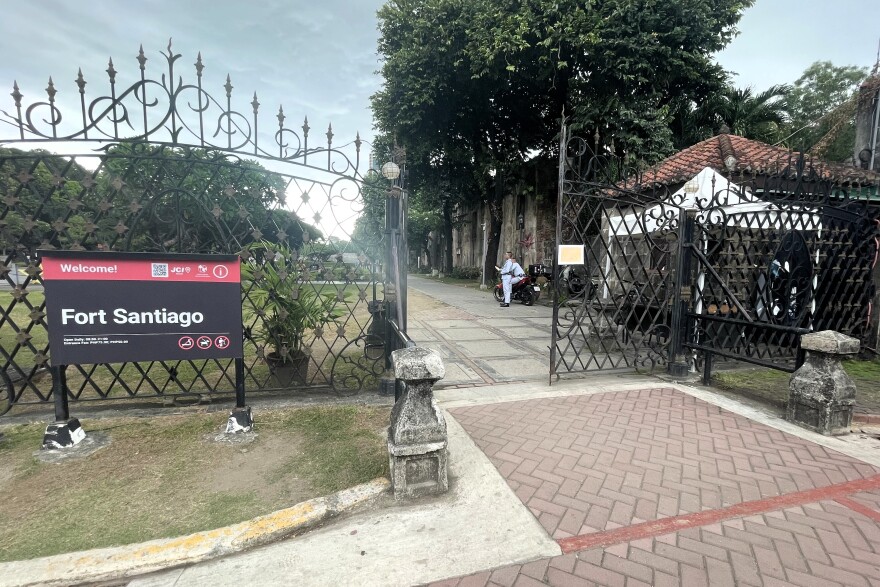Join KPRG's Naina Rao on a walking tour of Fort Santiago in Manila’s Intramuros, where centuries of history, resilience, and the legacy of José Rizal come to life.
TRANSCRIPT
JEFFERSON CRONIN/HOST: History is alive in the Philippines. Especially within the walls of Intramuros, Manila’s oldest district. It’s a place where centuries of Spanish colonial rule, wartime occupation, and the fight for independence are etched into the stone. KPRG’s Naina Rao takes us on a walk through Fort Santiago, a fortress that has stood witness to some of the most pivotal moments in Philippine history. Here’s her audio postcard.
[ON LOCATION: Fort Santiago, Intramuros]
(SFX: Footsteps echo on cobblestone, occasional chatter of tourists)
NAINA RAO: The breezy winds here are rich with history. Standing at the entrance of Fort Santiago, centuries-old stone walls rise high above me where it was once a symbol of Spanish power in the Philippines. The gates are adorned with intricate carvings. Just beyond them, the past unfolds step by step as I take a walking tour of the fortress. Betty is my tour guide.
(SFX: Tour guide’s voice fades in)
BETTY: Right now you are here at Fort Santiago. Fort Santiago is the main Citadel, or the fortress of the old Manila. The Intramuros name came from two Latin words, which is intra meaning within, and Moros meaning walls. That's why it is called within walls, or the walled city of Manila. So Intramuros was established by the Spanish Governor General Miguel Legazpie. And it was established in 1571 so it became a colonial seat for military, political and religious power for over 400 years, until it was damaged or destroyed by World War Two. Right now you are here at Fort Santiago. Fort Santiago is the main Citadel, or the fortress of the old Manila.
(SFX: Faint footsteps)
RAO: Walking through these grounds, it’s impossible to ignore the presence of José Rizal. He was a writer, doctor and a national hero.
BETTY: He exposed the realities of the Spanish colonization here in the Philippines. And when the Philippine Revolution broke out in 1896 imprisoned and sentenced to death. The white building over there is where he was in prison from November three until December 29 in the morning of 1896 and it is now the Museum of Dr Jose Rizal.
(SFX: Going down to the dungeon of Fort Santiago)
RAO: Further down a plaza in the middle of the citadel, I’m led to an underground dungeon of Fort Santiago. It was initially used for storage of powder magazines. But due to its proximity to the river, dampness caused problems. It was repurposed into something more grisly after.
BETTY: And in here, the political enemies of Spain was imprisoned and tortured. And during the Japanese occupation, there are 75 people murdered inside, killing them with suffocation and starvation.
(SFX 4: Pasig river ambience)
RAO: But beyond its somber past, Fort Santiago is a place of resilience. Just beyond the dungeon walls, the Pasig River glistens in the late afternoon sun from the lookout of Falsabraga Media Naranja.
BETTY: It is named media naranja because of its half circular shape, like a half orange media naranja. So this is a false wall another, another part of Intramuros, which is used for defense, so that one is the Garita or the lookout post for the gorgeous appeal. So imagine there are soldiers here looking over there if there are invaders. So they're the ones who protect the this area. And across the river, this is the Pasig River. Across the river is the San Nicolas and Binondo. So San Nicolas and Binondo is the home of the Christian Chinese and the famous Manila Chinatown.
RAO: As the sun sets over Intramuros, the old walls of Fort Santiago seem to whisper the stories of a familiar past. Standing here, I can’t help but feel like I’m back in Guam.
RAO: At the outpost there was like this structure, an outpost structure with the statue of a soldier that looked very similar to the one in Umatac's Fort Soledad. From the stones to, the color, the sentry box, all of that is very similar. How the walls are structured is they're slanted. They're stoned slanted walls. That's similar to Fort Apugan near the governor's mansion in Guam, the architecture has similarities to historical sites in Guam, probably because of the Spanish Empire. 100% because of the Spanish Empire.
(SFX: Fading sound of bells at the exit of Fort Santiago)
RAO: For KPRG News, I’m Naina Rao.
KPRG News transcripts are created on a rush deadline by a KPRG contractor. This text may not be in its final form and may be updated or revised in the future. Accuracy and availability may vary. The authoritative record of KPRG's programming is the audio record.


